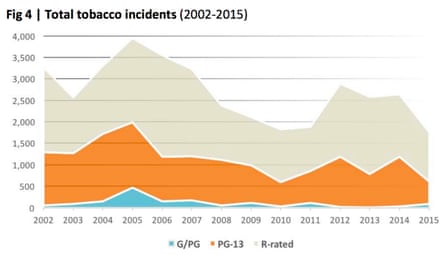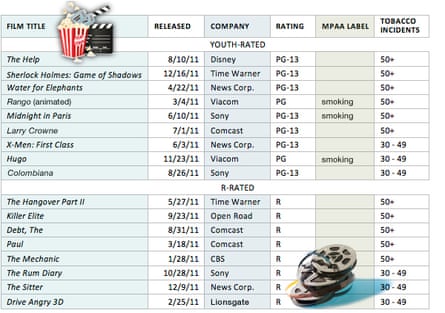Smoking scenes still regularly occur in movies deemed suitable for children, despite significant evidence that they can cause adolescents to take up the habit. The data about cigarettes on screen is relevant right now because a lawsuit is seeking to ban tobacco appearances in youth-rated movies.
In 2015, 47% of films rated PG-13 had at least one occurrence of smoking or tobacco use according to the Centers for Disease Control and Prevention (CDC). That figure has fallen since 2014 but the CDC still notes that “individual movie company policies alone have not been efficient at minimizing smoking in movies”.
To defend itself against the recent legal claim, the Motion Picture Association of America (MPAA) has said that prohibiting smoking imagery in films would amount to restricting free speech under the first amendment.

In particular, the CDC calls out the Walt Disney Company and 21st Century Fox for having created 56% of the youth-rated movies in which tobacco appears. By contrast, Comcast and Viacom have made progress since 2014 according to the CDC.
But some films are smokier than others. A 2011 study led by Stanton A Glantz, director of the Center for Tobacco Control Research and Education, found that several films which contained scenes with cigarettes were still not being labelled as “smoking” films by the MPAA.
Looking at the box office, Glantz found that the 134 top-grossing films of 2011 depicted nearly 1,900 tobacco “incidents” (a definition that includes implied use of a tobacco product – for example if an actor is seen holding an unlit cigarette).
These were particularly common in period movies like Sherlock Holmes: Game of Shadows and Midnight in Paris (both rated PG-13, both of which had more than 50 tobacco incidents). But the research also showed that fantasy films aimed directly at children like The Twilight Saga: Breaking Dawn – Part 1 contained plenty of tobacco scenes too.

Last year, the World Health Organisation published a comprehensive report which looked at the link between smoking on screen and adolescents taking up the habit. They, like the US surgeon general and the US National Cancer Institute, reviewed empirical evidence and found a causal link between the two.
That empirical evidence included several brain studies. In one, when participants were shown film segments that included right-handed adult smokers, their brains lit up in areas that are responsible for craving as well as those that are in charge of motor planning for the right hand. The findings suggested that, after watching actors smoke, participants were mentally preparing to light a cigarette too.
Nationally, smoking rates have fallen. In 2014, 17% of US adults were smokers compared to 21% in 2005. But tobacco use is far from obsolete in the US. Every day, more than 3,200 people under the age of 18 will smoke their first cigarette, according to the CDC.

Comments (…)
Sign in or create your Guardian account to join the discussion